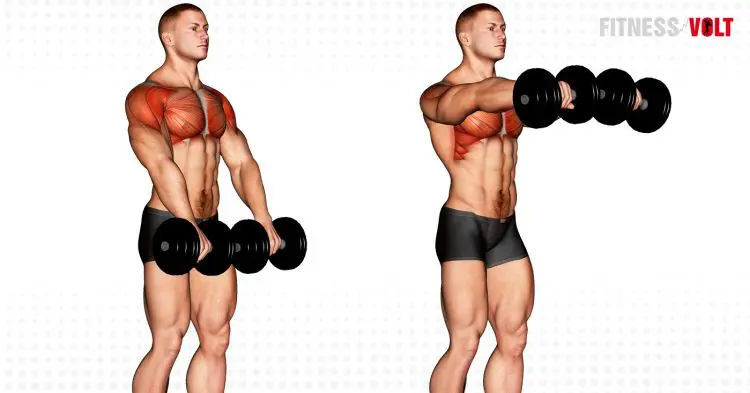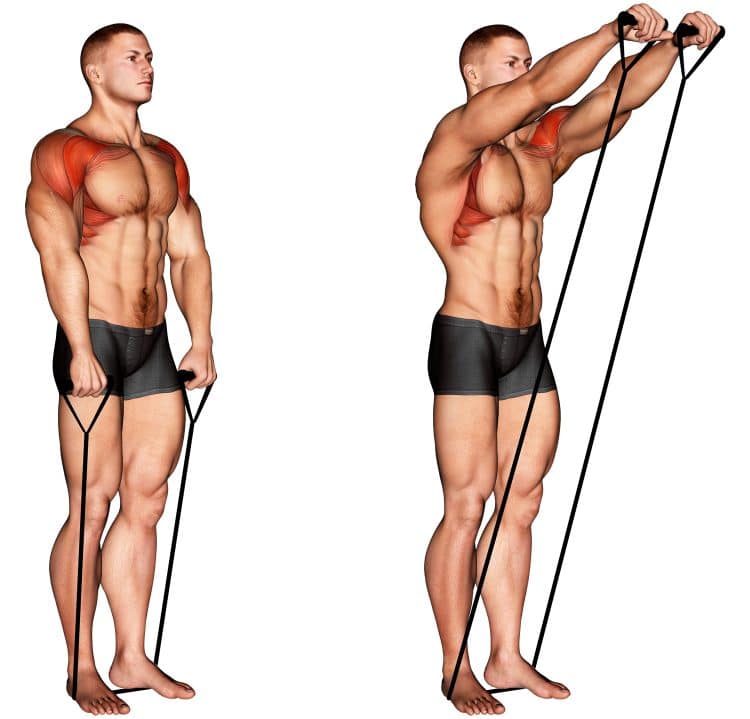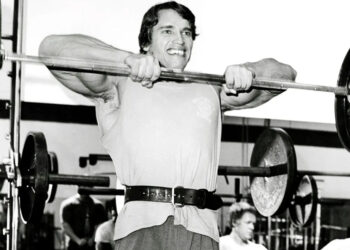The band front raise is an accessory shoulder exercise that targets the front-facing head of your tri-muscle deltoids just above the biceps. Every time you go for a handshake, open a door or raise your arms overhead, remember that it’s your front delts flexing the arm forward. If you want to increase the size of this muscle and gain more pressing strength, then it makes sense to prioritize some extra training for this small, but important section of muscle fibers.
As an added bonus, you’ll emphasize the upper chest muscles, which often lack volume compared to the lower pecs. So really, it’s a win-win strategy.
Let’s talk about proper band front raise technique, common mistakes, grip modifications, and the best variations and alternatives.
In This Exercise:
- Target muscle group: Deltoid anterior
- Type: Hypertrophy
- Mechanics: Isolation
- Equipment: Resistance band
- Difficulty: Beginner
Muscles Worked During Band Front Raises
It is very important to know what muscles you’re training during each exercise. This will allow you to focus on feeling a contraction in that muscle while using the best possible technique. Here’s some anatomy on muscles worked during band front raises.
- Deltoid anterior – A forward-facing muscle shielding the front shoulder joint, the anterior deltoid lifts the arm forward with help from the pectoralis major clavicular head. The same movement in a front band raise.
- Pectoralis major clavicular head – Connected to the clavicle or collarbone, both the front deltoid and pectoralis major clavicular head work together in raising the arm in front of the body.
- Serratus anterior – A chest muscle that runs along the ribs and attaches to the scapula, serratus anterior creates arm protraction by pushing the shoulder blades forward. It also joins certain trapezius fibers to lift the arms overhead.
How To Do Band Front Raises
The band front raise technique is so simple that anyone can do it regardless of their training experience. However, choosing the right band and knowing how to use it effectively is where it becomes a little more challenging.
Level Up Your Fitness: Join our 💪 strong community in Fitness Volt Newsletter. Get daily inspiration, expert-backed workouts, nutrition tips, the latest in strength sports, and the support you need to reach your goals. Subscribe for free!
We’ll have some tips to help you choose the right band later on in this guide.
Steps
- Grab your band with a wide grip then anchor it down with both feet. Use a narrower stance for less resistance or a wider stance for more of a challenge. Likewise, you can use a narrow, shoulder width, or wider grip.
- Stand up tall, keep your head up, and look straight ahead.
- With your arms straight, lift the band up in front of you and stop once it’s roughly level with the top of your head.
- Slowly drop your hands to your hips but maintain tension in the band.
Watch a short video demonstration of band front raises below.
Tips
- A band with handles will allow you to do alternating front raises.
- If you have pre-existing shoulder issues, or feel discomfort using an overhand grip, go to the hammer (neutral) or supinated (Palms facing up) grip.
- If you cannot lift the band to higher than your chest, you’re using too much resistance.
Benefits of Band Front Raises
Aside from the benefits of training your front delts, in general, it’s not a stretch (Pun intended) to say that using a band has its advantages.
May be safer for your shoulders
Resistance bands must stretch to create resistance and tension in the muscles. And the more it stretches, the more challenging the exercise. So what does that have to do with the front delts?
Well, because the shoulders function as a ball and socket joint, the excessive range of motion can also make them more susceptible to trauma.
Build titanium front delts and jacked upper pecs
While lagging front delts are a rarer commodity than underdeveloped rear facing delts (We tend to emphasize anterior movements like bench and shoulder press, and dips more than pulls), some can benefit from training them separately.
In comparison, the upper chest is a common weak point for a lot of lifters. The action of front raises follows the direction of your pectoralis major clavicle fibers. So you might as well kill two birds with one stone (No animals were harmed while writing this article).
Ultra convenient
Band front raises are a suitable alternative when you don’t have access to gym equipment. Not because they are less effective. But it’s just easier to determine how much weight you’re using, and when you’re progressing. Unless you have several bands of varying resistance.
Common Mistakes During Band Front Raises
Don’t underestimate how accurate you need to be with resistance bands to ensure effective, symmetrical training. As simple as bands may be, you can throw off a good exercise by ignoring good strategy and technique.
Using short range of motion
This typically happens when the band is too strong for the lifter. There are two reasons you don’t want to go short on the movement.
Your shoulders will suffer from the excessive load, and you’ll limit the muscle’s potential by not training through its entire movement capabilities. Drop your ego and lower the resistance, even going to the light bands. But make sure there’s resistance from start to finish.
Using too much range of motion
The bands only need to be lifted to head height. Any higher and you’ll start activating more of the trapezius muscles.
Level Up Your Fitness: Join our 💪 strong community in Fitness Volt Newsletter. Get daily inspiration, expert-backed workouts, nutrition tips, the latest in strength sports, and the support you need to reach your goals. Subscribe for free!
Using too much traps
You will involve the traps to some degree in band front raises. However, you want to avoid shrugging your shoulders as it creates momentum or take tension from the front delts. Do your reps nice and slow, and focus on feeling the anterior head work.
Asymmetrical sides
From anchoring the band down with your feet, to ensuring equal sides, and your technique (not focusing on using equal force on both sides), you need to have a checklist before you start training.
Don’t carelessly step on the bands without ensuring both sides are equal, or everything will be off and you’ll be training one side more than the other.
Variations of Band Front Raises
Depending on the tools at your disposal, you can do front raises several different ways. You will most likely find that you prefer one over the other, or you may like to rotate between them all. Check out the most common front delt raises below.
Cable front raise
You could argue that the cable one-arm front raise is the best overall technique for isolating the front delts. Unlike bands, the resistance stays the same from start to finish. But the biggest advantage is that you can position yourself far enough from the machine so the cable pulls your arm back behind your body and stretches your front delts.
Additionally, you have a numbered weight stack making it easier to remember your progress.
Seated band front raise
Sitting variations offer comfort and stability as it takes much of your bottom half out of the movement. Take a seated dumbbell press, for example. It’s easier to get the weights into position, you have back support, and don’t have to worry as much about stabilizing yourself. While not quite the same when using bands, hopefully you get the point.
As for anchoring the band, you could also use your feet, or wrap the band around a base (e.g., the legs of a bench, or a chair).
Hammer or supinated grip band front raise
If your shoulders are not agreeing with a palms down grip, try a neutral or palms up grip. This will turn the shoulder outward (External rotation) and place less force on the joint. In fact, we’d argue that if you’re doing very heavy front raises, you should apply this grip anyway.
Dumbbell front raise

Undoubtedly the most popular way to isolate the front delts, dumbbell front raises are the standard when they’re accessible. Likely because they engage the stabilizer muscles in the shoulders better than other implements, are unilateral (Train both sides separately), and convenient to grab off the rack and jump right into.
Barbell front raise
While just as powerful of a shoulder exercise, the barbell front raise is probably the least common variation on our list. You may be able to use more overall weight which seems to be the only advantage of using a barbell. However, it is an option to mix things up and try something different.
Bonus: Band front raise jacks
To train your muscles explosively, you can combine a jump with the band front raise.
You want to start with the feet closer together, then simultaneously jump your feet wide apart while performing a front raise. Use a single band, not the handled ones for this variation.
FAQs
What are the best sets and reps for band front raises?
There’s no sure answer to this. But… you should aim to make consistent weekly or bi-weekly progress by increasing the resistance and/or performing more repetitions.
What is the best type of band to use for front raises?
It truly does not matter so long as you can perform the movement using a full range of movement, while challenging yourself and not placing too much stress on your deltoids.
Therefore, you can use either the looped style bands or the type with separate handles.
Is it possible to overtrain the front delts with band front raises?
If you have well developed front delts, the less training volume you’ll need. If you could use a little more anterior delt size and strength then add a few extra sets after your shoulder workouts or on accessory training days.
Wrapping Up
Whether you’re tired of those flat front delts or you need a quick and convenient exercise to hit them on your off days, band front raises are the perfect complement to your shoulder training. While beginner friendly, don’t underestimate how precise you should be when utilizing resistance bands.
Take your reps through full range of motion, and if something feels off, stop and lower the load or change your grip for healthier shoulders.
Program band front raises alongside your other shoulder movements as needed to bring up or maintain the anterior head.
Interested in measuring your progress? Check out our strength standards for Dumbbell Front Raise, Shoulder Press, Dips, and more.









